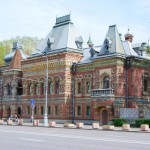Fairy Palace on Yakimanka
A mosaic mansion, resembling an old Russian palace, was built by the well-known manufacturer Nickolai Igumnov not far from Kalujskie Vorota. In 1888 he bought a piece of property here with a little wooden house on it from a second-guild merchant Nickolai Lukjanov and immediately forwarded a petition for the construction of a new stone house.
His choice of location surprised many. In those times this area was far from being respectable and hardly considered as prestigious. Squalid facades of neighboring houses could spoil any architectural project. Nevertheless Nickolai Igumnov explained his choice by the fact that he himself was born and raised in this neighborhood. It is not beyond supposition, though, that the manufacturer purposely wanted to build his apartments in a rather lonely place, far from curious eyes.
The Death of the Architect
Nickolai Igumnov was one of the owners of a famous textile mill in Yaroslavl. Probably, this old Russian city was associated for him with his most affectionate feelings. So it was not a coincidence that he invited an architect from Yaroslavl, Nickolai Pozdeev, to build his mansion on Yakimanka.
Pseudo-Russian style, which was very fashionable in those days, was chosen for the project. This trend in architecture drew upon the images of old Russian wooden palaces. The most famous of them is the palace of King Alexey Mikhaylovich in Kolomenskoye, which was pulled down in the XVIII century by the decree of Catherine the Great after it had become “utterly dilapidated”. Other elements of the mansion’s decoration were borrowed from church architecture with a harmonious composition of brickwork, masonry and encaustic tile. Igumnov was unfathomably rich and did not spare any money for the construction. The bricks were imported from Holland and tiles were made at the famous china factory owned by Kuznetsov.
In 1893 the mansion was finished. Pozdeev was able to combine into one entity many details of the exterior decoration: picturesque hipped roofs, clogheads, vaulted arches, columns. The building acquired a harmonious look, although a little too massive.
But Moscow architectural community did not accept the stranger. The mansion had not even been built yet when it became an object of sweeping criticism. Igumnov, who gave in to the public opinion, was quickly disappointed in his architect from Yaroslavl and refused to pay for the expenses that exceeded the original estimate. Disheartened and ruined architect committed a suicide.
The Ghost of a Dancer
It is difficult to say whether the tragic end of the architect caused the fact that Igumnov’s mansion was always surrounded by a cloud of gloomy legends. According to the most well-known one, the owner lodged in this fancy palace one dancer who was his mistress; but when he established that she was not being faithful to him, he had this poor woman bricked up in a wall alive. People say that since that time her ghost has been roaming the halls of the mansion, disturbing the peace of its dwellers.
According to another tradition which is not so sinister but nonetheless fantastic, one day Igumnov decided to surprise his guests and ordered to cover the floor in one of his reception rooms with golden coins. Naturally, on those coins there was the Emperor’s profile which Igumnov’s guests had no choice but to tread upon. The rumors of such disrespect toward the reigning monarch, seemingly, reached Saint-Petersburg. The court did not like it and merchant Igumnov had to make arrangements for a hasty departure from Moscow to his estate in the South. The house was unoccupied for a few years. And then the Revolution broke out.
The Brain Chamber
In 1917 in the requisitioned mansion there was a club-house for the workers of Goznak (the printer of bank notes and securities). It seemed though, that this fancy house’s destiny was not to be a place of joy and merry-making. Still in 1925 the club-house had to move out and Igumnov’s house was filled with people in white coats. A laboratory, created to study the brain of the late leader of the world’s proletariat — Vladimir Lenin — started its functioning here. German neurobiologist Oskar Fogt was invited to head up this institution. In 1928 the status of the laboratory was uplifted to the Institute of Brain Studies
Pages: 1 2

